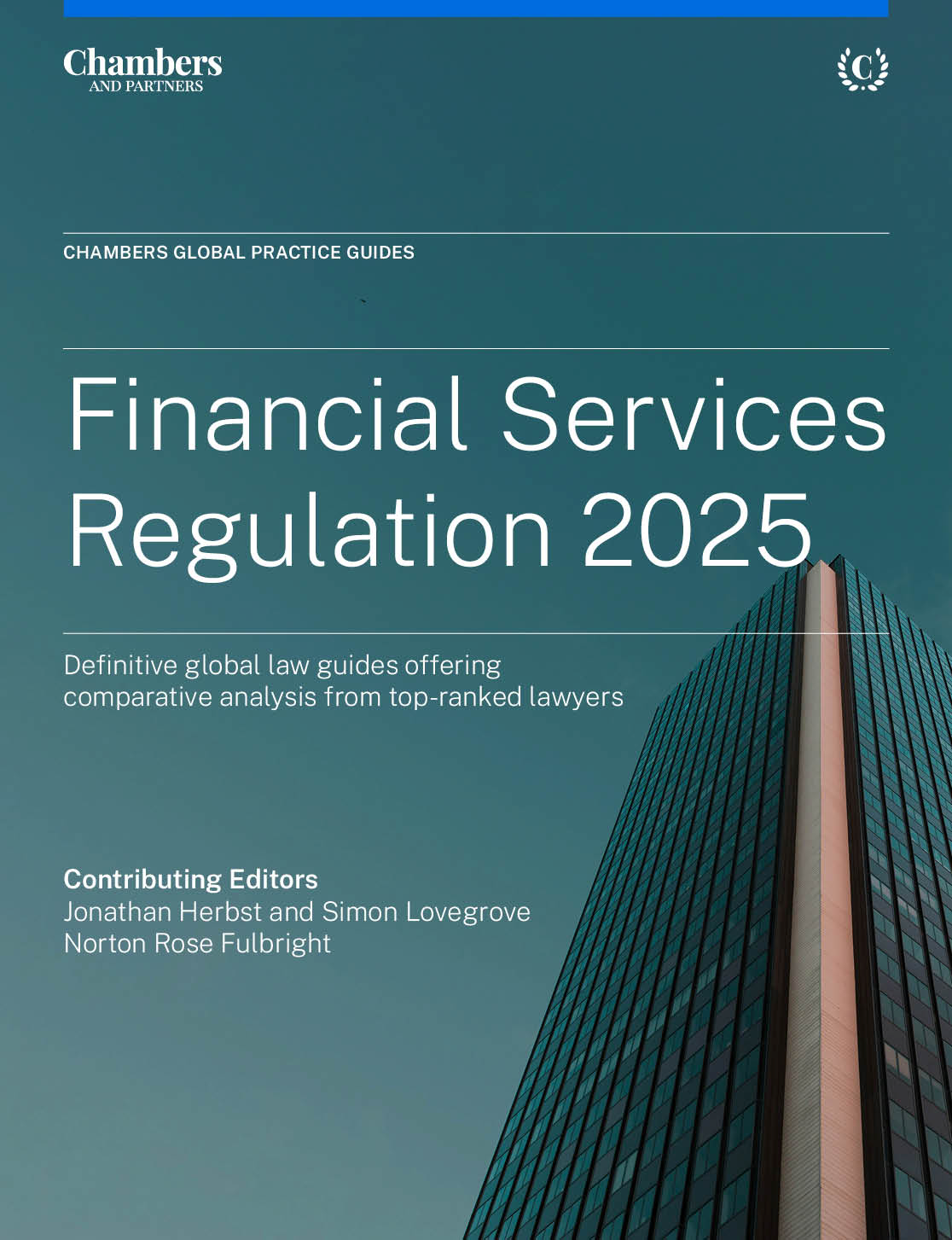
Financial Services Regulation 2025
The new Financial Services Regulation 2025 guide covers close to 20 jurisdictions. The guide provides the latest legal information on key financial services legislation, regulatory scope and exemptions, crypto-asset regulation, primary regulators and their guidance, major regulatory focus areas (including Basel III, settlement cycles, ESG, AI, fintech, retail banking, and shadow banking), authorisation processes and timelines, and anticipated financial services reforms.
Last Updated: November 20, 2025
Compare law and practice by selecting locations and topic(s)
Select Locations

Select Topic(s)

Please select at least one location and one topic to use the compare functionality.
Interesting Times
The financial services sector is undoubtedly experiencing a period of significant change and complexity, with the pace and breadth of transformation arguably greater than at any time in recent memory. At present, financial institutions across the globe are navigating a mixed and often unpredictable economic outlook, with factors that warrant both optimism and caution. The sector faces a challenging environment characterised by ongoing inflation, geopolitical uncertainty, and rapid technological advancement. In addition, the aftershocks of recent global events – such as the COVID-19 pandemic and ongoing geopolitical tensions – continue to reverberate, adding further layers of uncertainty. As a result, institutions are striving to balance the pursuit of growth with a strong emphasis on risk management, resilience, and, perhaps most critically, adaptability in the face of constant change.
Of these priorities, adaptability has emerged as particularly vital, especially in the context of digital transformation and the accelerating adoption of new technologies. Many financial institutions are fast-tracking their digital initiatives to streamline operations, reduce costs, and enhance the customer experience. This includes the adoption of artificial intelligence (AI) and machine learning to automate routine processes, as well as exploring new markets such as crypto-assets and digital platforms. The ability to adapt quickly to changing circumstances, regulatory expectations, and technological developments is proving essential for sustained success and long-term competitiveness.
Regulators have also responded actively to these evolving challenges, often with a sense of urgency. Geopolitical tensions are increasingly influencing the adoption and regulation of technology, with issues such as data sovereignty, cybersecurity, and the use of foreign technology providers becoming more prominent in regulatory discussions – particularly as concerns about state-sponsored cyber threats grow. The proliferation of fintech, digital assets, and new payment systems has prompted the introduction of new regulatory frameworks and oversight mechanisms. There is also a heightened regulatory focus on consumer protection, as consumers are now exposed to a broader array of innovative and sometimes complex financial products, which can present both opportunities and risks.
Deregulation also remains an important theme in certain jurisdictions. The Trump administration in the United States (USA) is leading the deregulation charge as a means of stimulating economic activity, a trend that has also been observed in the United Kingdom (UK) with the announcement of the so-called Leeds Reforms, and more recently green shoots of deregulation have been observed in Australia. While there is some movement towards harmonising global standards, significant regional and national differences persist – particularly in areas such as crypto-asset regulation, where the European Union (EU) has taken the lead with the Markets in Crypto-Assets Regulation (MiCA), while the UK and USA are working to catch up. The aftermath of Brexit has further contributed to regulatory fragmentation, with the EU and UK continuing to diverge on key rules. Consequently, financial institutions must navigate a complex and evolving patchwork of regulations, requiring constant vigilance and strategic agility.
The 2025 Global Practice Guide
This Global Practice Guide begins by outlining the fundamentals for each jurisdiction, including the key financial services regulators and the principal pieces of legislation. While these may seem basic, they are essential for anyone conducting research on a particular market or considering market entry.
The Guide then addresses the regulatory perimeter and the process of obtaining authorisation to provide financial services, including the timing and associated fees. In some jurisdictions, such as the UK, there has been recent commentary from regulators regarding efforts to improve processing times. As part of the authorisation process, some jurisdictions have particular rules or guidance regarding the establishment of a branch or subsidiary, noting that regulatory requirements for branches are generally lighter than for subsidiaries, but this varies by jurisdiction. Also, as part of the discussion regarding the authorisation process, the Guide examines whether senior individuals within firms are subject to direct regulatory approval – a requirement that is common, though the stringency of individual accountability regimes varies. For instance, the UK’s Senior Managers and Certification Regime is notably robust, although current deregulation proposals may impact its scope.
Included in the regulatory perimeter section is a question regarding crypto-assets. Crypto-assets remain a major focus, with the MiCA providing a comprehensive regulatory framework in the EU, while Hong Kong, the USA, and the UK are developing their own approaches.
In Hong Kong the Stablecoins Ordinance took effect on 1 August 2025 and the Hong Kong Monetary Authority has issued certain related papers, including an explanatory note on licensing of stablecoin issuers and related guidance. In July 2025, the USA passed its first federal law, the GENIUS Act, focusing on stablecoin issuance. At the time of writing, two further Bills – the CLARITY Act and the Anti-CBDC Surveillance State Act – had passed the House of Representatives and were under consideration in the Senate. The UK is also moving forward with its own crypto-assets regime but critically it is taking a different approach to the EU, expanding the scope of its existing framework to include crypto-assets rather than creating a standalone regime. Under draft legislation, new crypto-asset-related regulated activities will be created that are similar to existing ones for traditional assets. Crypto-asset firms with UK customers will also be required to meet clear standards on transparency, consumer protection, and operational resilience in the same way as firms in traditional finance. As for the accompanying regulatory rules, the Financial Conduct Authority is in the process of publishing a series of papers, with the intention that the new regime will come into force sometime in 2026.
Areas of Regulatory Focus
While many resources address the basics of financial services regulation, this Guide aims to focus on current developments that are likely to have a significant impact on financial institutions. Given the breadth of ongoing changes in the sector, it was necessary to select a limited number of topics, though authors have a great deal of discretion in the final horizon scanning section to highlight additional issues they deem relevant to their jurisdiction.
The Guide begins with capital adequacy and the implementation of the final Basel 3.1 reforms. These reforms are intended to strengthen the global banking system and are designed to improve banks’ own measurement of risk, standardising approaches between banks to make their capital ratios more consistent and comparable. However, the reforms have faced criticism – particularly in the USA – for their complexity and the potential to constrain banks’ lending capacity. As the USA has yet to implement the reforms, some other jurisdictions, including the EU and UK, have delayed certain aspects of the regime.
Settlement processes are also undergoing significant transformation. Major markets such as the USA and Canada have already moved to T+1 settlement, with the EU and UK expected to follow soon. This shift requires all market participants – including brokers, custodians, clearinghouses, and asset managers – to be operationally prepared for a shorter settlement cycle. Regulators may also require enhanced disclosure to ensure that investors understand the implications of T+1 settlement, including the need for timely funding and the potential consequences of settlement failures. All firms that participate in wholesale markets are likely to be impacted in some way by this change, but the operational changes and challenges faced will likely differ from firm to firm depending on, among other things, their business models, the settlement systems being used and the capacity for those systems to be upgraded.
Sustainability and ESG regulation remains a key area of focus. While the USA has seen a degree of federal retrenchment due to the Trump administration’s deregulation agenda, many countries, particularly those in Asia, are strengthening disclosure requirements and aligning with international standards, such as those issued by the International Sustainability Standards Board. Enforcement activity varies by jurisdiction; for example, Australia has seen significant enforcement activity, while the UK has been less active despite anti-greenwashing rules being in place for over a year.
AI and fintech continue to be prominent topics in financial services regulation. Regulators globally recognise both the opportunities and risks associated with AI and are updating model risk management frameworks to address issues such as bias, transparency, and accountability. Many have established innovation hubs or regulatory sandboxes to encourage responsible fintech innovation, and there is a concerted effort to ensure that fintech firms are subject to equivalent regulatory standards as traditional financial institutions, particularly in relation to anti-money laundering. Open banking and open finance initiatives are also gaining momentum, with the EU, UK, Australia, and Singapore all implementing relevant frameworks.
As regards central bank digital currencies (CBDC), different countries are at varying stages. For example, Bahamas, Nigeria, Jamaica have issued CBDCs. Elsewhere there are pilot trials and consultations. For example, in Sweden there has been the eKrona pilot which has been focusing on retail use and integration with existing payment systems. For Europe as a whole, the European Central Bank (ECB) completed its investigation phase into a CBDC in 2023. The ECB’s current phase of work finishes at the end of 2025, at which point the ECB’s Governing Council will decide whether to move to the next phase of preparations and, if so, define its scope and duration. In the UK, the Bank of England and HM Treasury are progressing work on a potential digital pound, currently in the design phase. But at the other end of the spectrum, CBDC development has at the moment been shelved in the United States in the sense that, on 17 July 2025, the US House of Representatives passed a bill prohibiting the Federal Reserve from creating a CBDC. Lawmakers considered the technology a threat to financial privacy and freedom, calling it incompatible with America’s fundamental democratic principles.
Retail financial services are being reshaped by technological advancements and changing consumer expectations. The trend towards the retailisation of wealth management has made these services more accessible to a broader range of investors, prompting regulators to enhance disclosure, suitability requirements, product governance, and oversight of digital platforms.
The protection of vulnerable customers is more critical than ever, with regulators emphasising the need for firms to identify and support those who may require additional assistance. The Guide contains a question asking what initiatives are in place to deal with this important issue. The approach to vulnerable customers may have evolved in jurisdictions. In the UK, for instance, the new Consumer Duty has changed how firms deal with vulnerable customers by requiring them to proactively identify and deliver good outcomes for these customers, but challenges remain in key areas like data monitoring, product design, and staff training, with vulnerable consumers still reporting poor experiences compared to others.
Horizon Scanning
The final section of the Guide is dedicated to horizon scanning, providing each jurisdiction with the opportunity to discuss those key financial services reforms that have not already been mentioned. We have deliberately given the authors free rein in this section as they will know best what the key initiatives are in their own jurisdiction. But there may be some similarities in approach. For example, given that the threat landscape is constantly changing, with cybercriminals and state-sponsored actors employing increasingly sophisticated tactics, one may expect to see discussion regarding operational resilience and cyber security. Other topics may be money laundering, regulatory enforcement and clearing.

